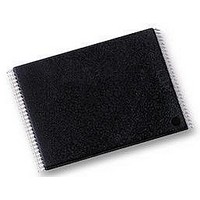S29AL004D70TFI010 Spansion Inc., S29AL004D70TFI010 Datasheet - Page 22

S29AL004D70TFI010
Manufacturer Part Number
S29AL004D70TFI010
Description
Flash Memory IC
Manufacturer
Spansion Inc.
Datasheet
1.S29AL004D70TAI020.pdf
(55 pages)
Specifications of S29AL004D70TFI010
Memory Size
4Mbit
Memory Configuration
512K X 8 / 256K X 16
Ic Interface Type
Parallel
Access Time
70ns
Memory Case Style
TSOP
No. Of Pins
48
Operating Temperature Range
-40°C To +85°C
Lead Free Status / RoHS Status
Lead free / RoHS Compliant
Available stocks
Company
Part Number
Manufacturer
Quantity
Price
Company:
Part Number:
S29AL004D70TFI010
Manufacturer:
SPANSION
Quantity:
5 530
Company:
Part Number:
S29AL004D70TFI010
Manufacturer:
SPANSION
Quantity:
1 690
Company:
Part Number:
S29AL004D70TFI010
Manufacturer:
SPANSION
Quantity:
6 250
Company:
Part Number:
S29AL004D70TFI010H
Manufacturer:
SPANSION
Quantity:
50
A d v a n c e
I n f o r m a t i o n
program set-up command. The program address and data are written next, which
in turn initiate the Embedded Program algorithm. The system is not required to
provide further controls or timings. The device automatically provides internally
generated program pulses and verifies the programmed cell margin.
Table on
page 24
shows the address and data requirements for the byte program com-
mand sequence.
When the Embedded Program algorithm is complete, the device then returns to
reading array data and addresses are no longer latched. The system can deter-
mine the status of the program operation by using DQ7, DQ6, or RY/BY#. See
Write Operation Status‚ on page 26
for information on these status bits.
Any commands written to the device during the Embedded Program Algorithm
are ignored. Note that a hardware reset immediately terminates the program-
ming operation. The program command sequence should be reinitiated once the
device has reset to reading array data, to ensure data integrity.
Programming is allowed in any sequence and across sector boundaries. A bit
cannot be programmed from a 0 back to a 1. Attempting to do so may halt
the operation and set DQ5 to 1, or cause the Data# Polling algorithm to indicate
the operation was successful. However, a succeeding read shows that the data is
still 0. Only erase operations can convert a 0 to a 1.
Unlock Bypass Command Sequence
The unlock bypass feature allows the system to program bytes or words to the
device faster than using the standard program command sequence. The unlock
bypass command sequence is initiated by first writing two unlock cycles. This is
followed by a third write cycle containing the unlock bypass command, 20h. The
device then enters the unlock bypass mode. A two-cycle unlock bypass program
command sequence is all that is required to program in this mode. The first cycle
in this sequence contains the unlock bypass program command, A0h; the second
cycle contains the program address and data. Additional data is programmed in
the same manner. This mode dispenses with the initial two unlock cycles required
in the standard program command sequence, resulting in faster total program-
ming time.
Table on page 24
shows the requirements for the command
sequence.
During the unlock bypass mode, only the Unlock Bypass Program and Unlock By-
pass Reset commands are valid. To exit the unlock bypass mode, the system
must issue the two-cycle unlock bypass reset command sequence. The first cycle
must contain the data 90h; the second cycle the data 00h (F0h). Addresses are
don’t care for both cycles. The device then returns to reading array data.
Figure 3, on page 21
illustrates the algorithm for the program operation. See
Table 12 on page 41
for parameters, and
Figure 17, on page 42
for timing
diagrams.
20
S29AL004D
S29AL004D_00_A1 February 18, 2005
















